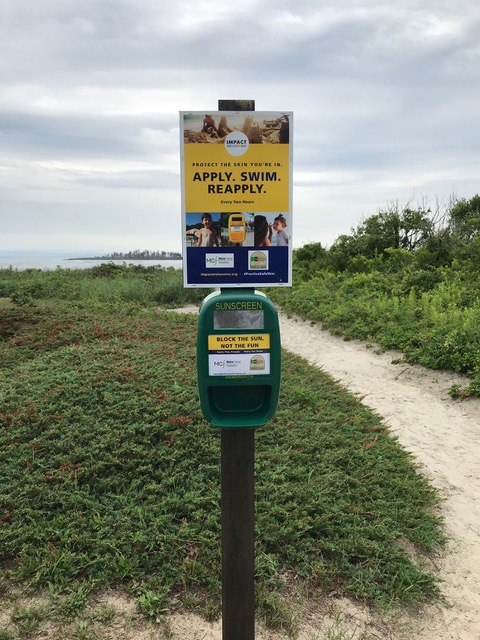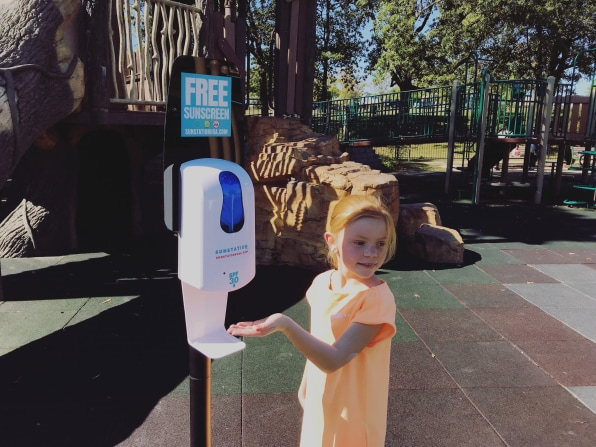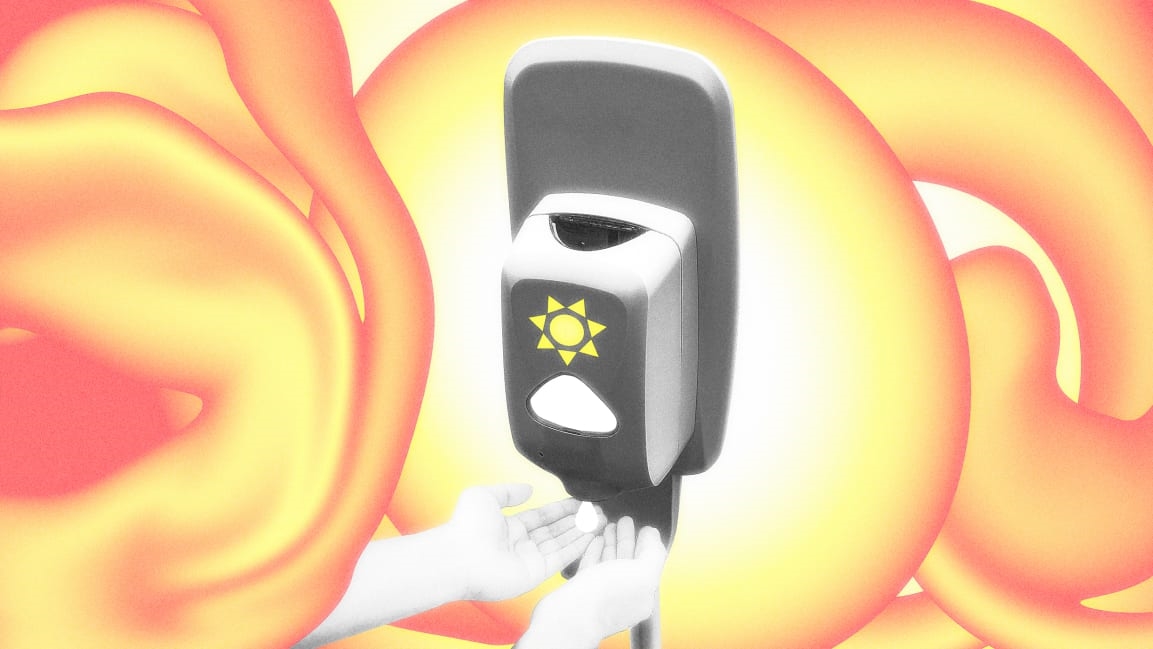Extreme heat could mean more skin cancer. This simple solution can help
It may be a surprise that Vermont, a Northern and relatively temperate state, has one of the highest (if not the highest) rates of melanoma in the country. That’s likely due to a range of reasons, including a largely white, older population; but also active and outdoor lifestyles, and tendencies to capitalize on intense bursts of the sun when it does emerge. That latter behavior may become more common: As temperatures rise, increasing the number of warm days in traditionally cooler places (and during typically cooler seasons), people might spend more time outdoors, increasing their exposure to carcinogenic ultraviolet radiation.
Those concerning rates have driven the Green Mountain State to increase its efforts to prevent skin cancer. Pivotal to this push are public sunscreen dispensers, and Vermont isn’t alone in installing them.
People across the country may be spotting sunscreen dispensers popping up on beaches, in parks, and by pools in their communities. Nearly visually identical to the hand-sanitizer dispensers we’ve grown accustomed to during COVID-19, they’re the result of efforts by municipalities and businesses to reduce the risk of skin cancer, as extreme heat is on the rise due to global warming. They provide a chance for people without their bottles of SPF to lather up—and they’re also a means for organizations to spread awareness about wider sun safety, which will be more necessary as we confront the threat of climate change.

IMPACT Melanoma is one nonprofit that offers melanoma education and early detection programs, plus support services for victims of the particularly aggressive form of skin cancer. The group first heard of public sunscreen dispensers in 2015 (someone spotted one at an amusement park in Pennsylvania), leading staff to create a business model of partnering with states and municipalities, executive director Deb Girard says, to “bring free sunscreen to communities across the country.”
Made by a separate company called BrightGuard, the dispensers IMPACT installs are fitted with bags of about 1,000 doses of SPF 30, reef-friendly sunscreen. They’re shatterproof, weather-resistant, and—an important pandemic feature—touch-free. They’re handy for people who’ve forgotten to bring their sunscreen out for a hike or a day at the beach, or who need to reapply. Only 10% of the U.S. population uses sunscreen everyday; almost half never wear it. Meanwhile, skin cancer is the most common cancer: 9,500 Americans are diagnosed each day, and one in five will get it in their lifetimes.
As climate change worsens, so could that threat of skin cancer. When considering UV exposure, we have tended to be more concerned with the depletion of the ozone layer, which soaks up potentially the most harmful forms of UV radiation. The ozone now seems to be healing, due to the phasing out of CFCs—but climate change’s role in sunburn is an increasing worry. More warmer days means we’re spending more time outdoors, sometimes without enough clothing and coverage, exposing ourselves to different kinds of UV radiation. Research has found that higher temperatures can exacerbate the carcinogenic effects of UVB radiation, potentially making UV rays more effective at creating tumors. What’s more, climate change also affects cloud cover, rainfall, and air pollution, all of which can influence the UV levels at the Earth’s surface. According to the EPA, melanoma rates have been on the rise over the past five decades.
Sunscreen dispensers, then, are an important form of prevention. But, for IMPACT Melanoma, they’re more of a marketing tool, and “a very tangible way that we could get our messaging out” about wider sun safety initiatives, Girard says. Each dispenser has a customizable backboard allowing for advertising, which IMPACT uses for messaging—to educate about proper application, to teach facts about sun protection, and to display the organization’s website. “The sunscreen dispenser is the vehicle,” she says. “It’s not the end-all.”
IMPACT runs various programs, including Skin Smart Campus, where it works with college campuses to develop policies around barring indoor-tanning amenities; and No Sun For Babies, which provides new parents with sun-shielding tips for their newborns. In hospitals now, from Atlanta to Boston, new parents are given a bag of goodies when they leave with their babies, including a UV-proof blanket for the infant. “This is what makes us different than just a business that sells sunscreen,” Girard says.
The dispenser-as-a-gateway method to more holistic cancer prevention has been implemented in places like Vermont, which has a melanoma diagnosis rate of 32.6 per 100,000. It’s “one of the bigger-burden cancers,” says Sharon Mallory, Comprehensive Cancer Control program director at the Vermont Department of Health. Since 2018, the department has partnered with IMPACT Melanoma to distribute its sunscreen dispensers across the state. States receive funds for cancer control from the CDC, and Vermont gives a small grant from that fund to IMPACT, paying for the dispensers and sunscreen, plus some technical support. In turn, it hopes that IMPACT’s messaging will educate state residents about broader sun safety.
The sunscreen in IMPACT’s dispensers are “broad spectrum,” meaning they should protect against the various types of UV radiation, if applied properly. There are about 30 of the dispensers across the state, mostly within 18 state parks, which offer the greatest threat for sun exposure in a landlocked but active state. “Are those 30 or so sunscreen dispensers going to make a noticeable difference on their own?” Mallory asks. “Maybe. Probably not.” But it’s about the bigger picture: They represent a reminder to folks to apply sunblock—even from their own bottles—and to implement other sun-protection measures. IMPACT has a similar partnership with the state of Maine, and other municipalities, from Wyoming to Boston. (Marge Simpson spots a dispenser when The Simpsons go to Boston. “So progressive!” she exclaims, as she dabs a palmful on Maggie.)

There are other dispenser competitors in the market. Sunstation USA, launched in 2016, also with its own brand of SPF 30, broad-spectrum, eco-friendly sunscreen, and works with municipalities from Boca Raton, Florida, to Midland, Texas, and Jersey City, New Jersey, to Park City, Utah—as well as Toronto, Puerto Rico, and Costa Rica. It’s usually local public health or parks departments, or even aquatic centers, that put in the orders, says CEO Ross Donaldson. Sunstation also works with businesses: hotels like Hilton and Marriott; pools and golf courses; and NFL and MLB stadiums. (IMPACT also welcomes business partners, Girard says, which can use the dispenser backboard for their own marketing, while actively providing a service for the public’s benefit.)
Donaldson says interest in the dispensers is growing, as extreme heat is becoming more of a threat. “When we started, most people had never seen a sunscreen dispenser before,” he says. Now, they’re receiving larger bulk orders—say, for an entire park or trail system, rather than a single dispenser. Sunstation works with the American Academy of Dermatology, which is matching community grants, dollar-for-dollar, to allow for more dispensers in more corners of cities and counties. Last year, Sunstation was able to give away sunscreen to 1.3 million people, and they say they’re on track to beat that figure this year.
Right now, it’s difficult to concretely gauge the impact of such dispensers, says Mallory of the Vermont Department of Health. But as the program expands and becomes more streamlined—she hopes it’ll integrate into the state parks budget—they’ll be better able to track progress. “Ideally, down the road, we’ll see a change in sunscreen-use rates, or sunburn rates,” she says. “And then, eventually, melanoma.”
(58)



